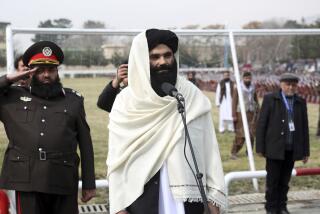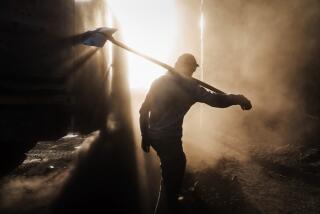Noose ‘Tightening’ Around the Taliban
- Share via
WASHINGTON — Taliban forces in the Afghan cities of Kunduz and Kandahar dug in Thursday for what could be the regime’s last conventional battles, even as U.S. Army Gen. Tommy Franks declared that American troops were “tightening the noose” around Taliban leaders and their allies in the Al Qaeda terrorist network.
In Kunduz, the remnants of Taliban forces in northern Afghanistan, including as many as 3,000 zealous foreign fighters, broke off negotiations with opposition soldiers and sought to fortify their defensive positions for battle. In Kandahar, in the south, Taliban troops skirmished with opposition groups and a small number of U.S. Special Forces troops.
But less than a week after the opposition Northern Alliance captured its first major city, Taliban forces continued to dissolve, as some fighters defected, others fled the country and still others sought to blend in with the Afghan population.
In western Afghanistan, more than 100 Taliban soldiers, including at least 19 top leaders, were captured Thursday. The opposition general in charge of the arrests said many of the men had changed their appearance by cutting their hair and shaving their beards.
Although that made positive identification difficult, turncoat Taliban forces tentatively fingered three of the men as the former governor of the Afghan capital, Kabul, and the former governor and the chief of police in Herat, in western Afghanistan.
In the Kandahar area, negotiations apparently were underway between tribal leaders and local Taliban commanders in an effort to get the hard-line regime to give up power without bloodshed.
And in eastern Afghanistan, as the Taliban fled the city of Jalalabad, long-exiled ethnic Pushtun leaders returned to their homeland, driving across the border from Pakistan to take over the governor’s palace.
Even as the Taliban appeared to be severely weakened and on the run, supreme leader Mullah Mohammed Omar warned Wednesday of the imminent demolition of the United States.
“The current situation of Afghanistan is related to a big cause--that is, the destruction of America,” Omar told BBC radio’s Pushtun-language service. “We will see this in a short time.”
Asked whether a concrete plan for such destruction existed, Omar replied: “The plan is going ahead, and, God willing, it is being implemented. But it is a huge task which is beyond the will and comprehension of human beings. If God’s help is with us, this will happen within a short period of time. Keep in mind this prediction.”
Omar had initiated the interview, according to the BBC, which could indicate that he was seeking to bolster the morale of his Pushtun-speaking followers. The Taliban has drawn most of its support from Pushtuns, Afghanistan’s dominant ethnic group.
Kandahar, the spiritual birthplace of the Taliban, is in the heavily Pushtun south. Franks said at a Pentagon briefing Thursday that U.S. Special Forces in the Kandahar area have set up roadblocks to help opposition allies fight Taliban forces in the area. U.S. warplanes conducted renewed strikes near the city Thursday.
Opposition sources said that there were growing divisions among Taliban groups in Kandahar and that Northern Alliance forces had surrounded the city and now control most of the province.
Franks, the commander of American military operations in Afghanistan, said U.S. teams had begun supplying arms and other supplies to southern groups.
Deputy Defense Secretary Paul D. Wolfowitz said that after a weeks-long search for southern groups to work with, U.S. military leaders were now reaching a growing number of such groups. They are “frankly coming out of the woodwork rather quickly now,” he told reporters.
Franks said that U.S. forces were increasingly focusing their work on their primary mission of finding and destroying the leadership of the Afghan regime and Al Qaeda.
He noted that U.S. warplanes began their air campaign Oct. 7 by hitting major fixed targets, then moved to troops and military vehicles. Now, as those targets are dissolving, U.S. forces are increasingly focusing on trying to hit the leaders--the “alligators,” Franks said.
“We’re tightening the noose,” he said. “It’s a matter of time.”
U.S. warplanes also continued to aid opposition forces Thursday with strikes on Taliban positions outside Kunduz.
The Taliban forces around the northern city gathered there last weekend after retreating from the fallen city of Mazar-i-Sharif and nearby areas. They number about 20,000, according to opposition commanders, and are led by foreign fighters from Saudi Arabia, Pakistan, the Russian republic of Chechnya and other areas. Franks described them as “hard core.”
Although the foreign fighters are now surrounded by opposition forces, they have refused to surrender, unlike many other Taliban groups. According to opposition leaders, the foreign fighters fear what will happen to them if they fall into the hands of the opposition. There have been reports of summary executions of Taliban fighters, especially foreign ones.
Franks said the U.S. forces on the ground in Afghanistan--who reportedly were joined Thursday by 100 British troops--also have begun investigating a series of sites where the Taliban is suspected of having sought to develop chemical, biological or even nuclear weapons.
One such site was a musty “safe house” in Kabul with laboratory equipment where Western reporters found documents relating to those weapons. But U.S. Homeland Security chief Tom Ridge said the documents contained information taken from the Internet that would have been widely available.
Franks said the search had made “no substantial findings” so far on what kinds of weapons-making capabilities the Taliban or Al Qaeda possesses.
The arrest of the Taliban forces in western Afghanistan on Thursday could provide valuable information on Taliban operations.
The forces were captured near the city of Gulran by troops loyal to Northern Alliance warlord Ismail Khan, opposition officials said.
At least 19 of those captured appeared to be Taliban leaders, despite their shaved faces, said Gen. Azizollah Afzali, who was in charge of the arrests. “They are telling lies. They never tell us their real names,” he said.
But they are believed to be Mannan Niazi, the former governor of Kabul; Mullah Baradar, former governor of Herat; and Mullah Samad, former head of police in Herat.
Elsewhere, negotiations appeared to be underway to bring about the surrender of other Taliban forces.
Both Hamid Karzai, a Pushtun leader who until recently lived in exile in Pakistan, and Gul Agha Shirzai, a former governor of Kandahar, were said to be in discussions with Taliban commanders near Kandahar.
These traditional tribal discussions, which Afghans have used for generations to settle disputes, could take several days but are considered unlikely to persuade all Taliban forces to accept a negotiated solution.
Conversations with Taliban fighters crossing the Afghan-Pakistan border suggested a high level of bravado Thursday.
Said Maulana Najibullah Shirzai, the Taliban deputy secretary of foreign affairs for Kandahar province, crossed back into Afghanistan after buying medicine in a Pakistani border town Thursday.
“We have a program, and we will reorganize our forces, and we will very soon start fighting against all non-Islamic forces,” he said.
Times staff writers Marjorie Miller in London; John Hendren in Washington; Alissa J. Rubin in Quetta, Pakistan; Megan K. Stack in Peshawar, Pakistan; and Soraya Sarhaddi Nelson in Herat contributed to this report.
More to Read
Sign up for Essential California
The most important California stories and recommendations in your inbox every morning.
You may occasionally receive promotional content from the Los Angeles Times.











